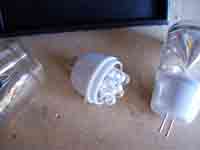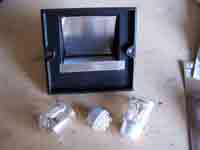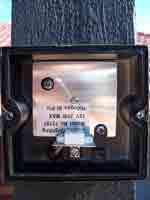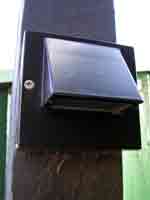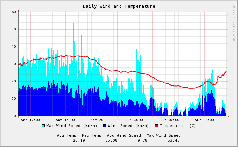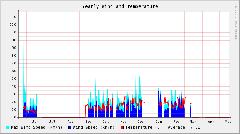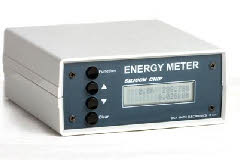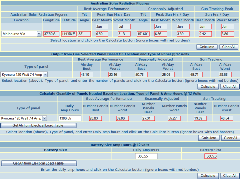


Usage Audit
It only takes a brief bit of research to learn that the best way to reduce the cost of a solar (or other renewable energy source) implementation is to actually reduce how much energy you consume in the first place.
I utilised the on-line solar design calculator located at the Rainbow Power Company website, and it indicates that I'd need between 29 and 60 120 Watt panels to accommodate our current power consumption requirements. Naturally this would be a bit cost prohibitive, not to mention I simply don't have that much roof-space, so an assessment of just where all of this power was being used was in order.
I decided to build the Silicon Chip Energy Meter, which I bought in kit form from Dick Smith for $127.00. Jaycar have a much cheaper unit, but was out of stock at the time. They're now back in stock, and apparently have a 'CO2' version, which provides a converted display showing CO2 emissions rather than watts.
Anyway, this unit allows you to calculate the total kilowatt-hours used per appliance, as well as the cost, based on the value you can input from your power bill. It also of course shows a watt-reading which is updated every 11 seconds. Some examples of places where excess consumption were discovered (and some were removed):
Item
|
|
The stereo/DVD/VCR/etc was drawing 53 watts with all equipment in standby mode.
|
|
|
Plug packs were drawing between 3 and 7 watts each without anything being plugged into them.
|
|
|
A washing machine draws ~7 watts in standby mode.
|
|
|
The fishtank's one of the primary sources of energy consumption; mainly due to the heaters, which were drawing ~3.9kwh per day (~164 watts). A friend (thanks Michael) suggested putting foam on the back to stop heat loss, so I took a quick trip to the local Clarke Rubber store, and purchased some pre-cut sheets that were enough to cover the back (6 foot by 2 foot) to a thickness of one inch (total cost under $20). I've also put some foam used to insulate copper pipes over the filter hoses (total cost $4). I had the power meter connected to the tank for almost a week, and it's now showing daily average consumption figures of 3.2kwh (~135 watts), or a reduction of 0.7kwh per day. Not bad for a ~$24 outlay. Sometimes its the simple things...
|
|
|
The two-door side-by-side fridge draws ~1.8kwh per day
|
|
|
A pedestal fan draws ~30 watts, and a portable evaporative cooler draws ~60 watts
|
|
|
A small (34cm) TV draws ~50 watts; the same or less than a small LCD TV, but at under $100 it's a fair bit cheaper. It also draws 13 watts in standby mode. A big TV is great, but is it really needed for all occasions?
|
|
|
A 19 inch CRT computer monitor draws ~86 watts
|
|
|
An electric toothbrush draws 2 watts in standby
|
|
|
An Energizer 4 AA battery charger draws 1.5 watts without any batteries in it.
|
|
|
A microwave draws 4 watts to run the clock
|
|
|
A 50 watt halogen lamp was actually drawing 67 watts
|
|
|
The evaporative cooling unit (no LCD display, just manual controls with a few LEDs) draws ~0.3 watts in standby
|
|
|
The UPS I was using draws between 50 and 66 watts in standby with nothing connected to it! I had a look at a couple in Jaycar and got them to measure the standby consumption before I purchased one. Basically the one I was using was way oversized, and so the charging circuits, fans, etc were scaled to suit.
|
Energy Efficient Lighting
Changing the vast majority of lighting to 8 or 11 watt compact flouro's has also reduce consumption by a noticeable degree.
I've also converted our garden lighting over from halogen to LEDs. Our back garden lighting was drawing a total of 240 watts across 18 lights (either 10 or 20 watt bi-pin halogens). I've converted all of those to 0.5 watt LEDs purchased from Bunnings (see images below). These fit directly into a standard BI-pin halogen fitting. They come with a removable cap which is supposed to be able to provide light-shaping, but which I basically found to be useless so have removed them.
I tried putting one of the LED modules directly into our post-mounted 20 watt garden lights (see images below), but understandably, the results were pretty dismal. This is largely in part because of the lighting design, that used a reflector to direct the light out of a frosted pane of glass below the bulb. This is actually a pretty damn inefficient design. With two 0.5 watt modules installed and pointing directly onto the glass, the light output is considerably more than the 20 watt halogen could provide.
With all 18 of the lights now converted, the power consumption has dropped to to a paltry 13 watts.
Bunnings sell the LED modules (HPM part number: DGLWLED) in packs of two for ~$21. While not cheap, retrofitting our existing garden lighting is still considerably cheaper than replacing them with new dedicated LED garden lights. I hope this eventually changes though as LED lighting becomes more common and affordable.
I've also purchased another 16 garden light housings the same as the one shown above, and have retrofitted those with the LED modules also. It'd be cheaper to get individual 1 watt Luxeon LED modules from somewhere like ATA, but then I'd have to make up bridge rectifiers, etc, and to be honest, to me the saving just isn't worth the extra effort.
I've then purchased a solar panel, some batteries and a charge controller, and am running the whole lot (as well as some other things) from solar. The following photo shows the entertainment area lit by the lighting at night, running from power generated from the solar setup.
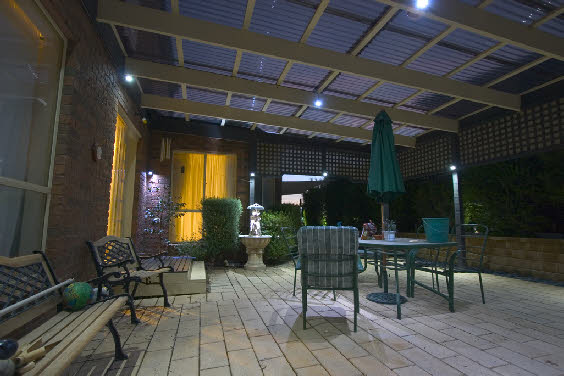
I've also purchased a 32 LED movement-activated spotlight with a detachable solar panel from Home Hardware for the backyard. It turns out this is the same model Jaycar sells, only under a different brand name. I was sceptical as to whether it was going to be any good, but am very pleasantly surprised with the results.
And of course, though it doesn't reduce consumption, electing to utilise electricity provided from renewable sources at least helps to sustain and develop renewable energy projects. We've elected to utilise 100% renewable electricity from AGL. There's a 5.5c per kwh premium on top of the existing rate, but hey, this should just help me focus the mind on how to find more areas to reduce energy consumption. One way is going to be for me to build a solar fishtank water heater.
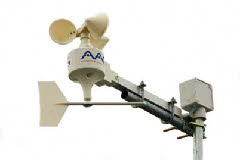
|
Item |
Power Usage |
Action Taken |
Modified Usage |
|
Stereo DVD/VCR etc |
53 watts (standby) |
Turn off at the wall |
0 watts |
|
Plugpacks from chargers, etc |
3 - 7 watts (standby) |
Turn off at the wall |
0 watts |
|
Washing machine |
7 watts (standby) |
Turn off at the wall |
0 watts |
|
Web server (Dell desktop PC) |
46 watts (operating) |
Changed to second hand Dell C600 laptop |
24 watts |
|
Halogen garden lighting |
240 watts (operating) |
Converted to LED |
13 watts |
|
Fish tank heaters (2 x 300w) |
163 watts (average operating) |
Insulated the back of the tank with foam, as well as exposed piping |
135 watts |
|
Microwave |
4 watts (standby) |
Turn off at the wall |
0 watts |
|
UPS |
60 watts (standby) |
Changed to a more efficient model |
22 watts |
